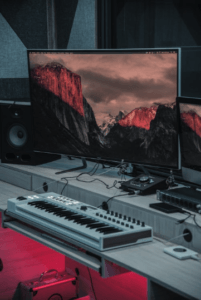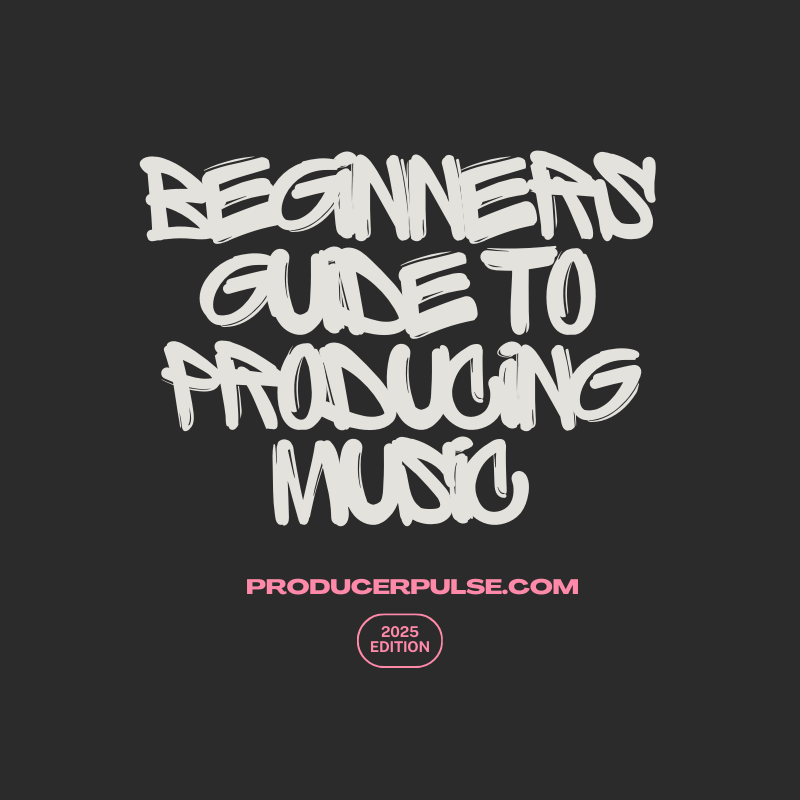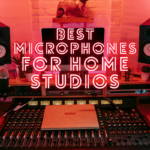Understanding where to start in music production might seem overwhelming at first, but getting the basics down can smooth the way. I remember how it was when I got started, that’s why I  wanted to write this beginners guide to producing music.
wanted to write this beginners guide to producing music.
The core of music production is taking sound creations, whether they start as a thought, a humming tune, or a full band recording, and turning them into polished audio tracks that folks love to listen to.
Music production has evolved from intricate, exclusive studio work to something you can do at home, sitting at a desk. The development of technology has powered this transformation—the digital audio workstation, or DAW, is a centerpiece here. DAWs bring recording, editing, and mixing capabilities to your fingertips without needing a full-fledged studio.
Home studios aren’t just for hobbyists anymore. They let anyone with creativity and drive produce music without needing a massive budget. It opens doors that were once locked to nearly everyone else besides industry professionals. With the right setup, you can have a home studio that outputs high-quality recordings on par with big-name producers.
Despite what some myths might say, you don’t need thousands of dollars’ worth of gear to get started. Many beginners fall into the trap of thinking they need the best of everything, which isn’t true. Yes, you need a computer, software, and some basic peripherals, but the difference in quality often comes from the skills of the producer rather than tools alone. Start with simple, cost-effective setups, and remember, creativity is your biggest asset.
Approaching music production with an open mind and a sense of curiosity is key. It’s not just about knowing the tech or having a perfect pitch; it’s also about understanding how different elements of music come together. With time, practice, and dedication, these initial steps will pave the way for producing tracks that truly resonate with listeners.
Beginners Guide To Producing Music: From Computers to Software
Getting into music production means you’ll need some essential gear, and picking the right computer is a solid first step. Not just any computer will do for producing music efficiently. You’ll want one that can handle the demands of recording, mixing, and running complex software smoothly.
Focus on a computer that meets certain specs. A solid processor like an Intel i7 or higher, at least 16GB of RAM, and a good amount of storage space (512GB SSD at a bare minimum) are crucial. This ensures your computer can handle multiple tracks and plugins without hiccups. Macs are popular for music production due to their reliability and seamless integration with many DAWs, but don’t discount PCs—they offer great performance too and can be more budget-friendly.
Once your computer is sorted, choosing the right DAW is next. There’s no one-size-fits-all here; it really depends on what suits your style and what feels intuitive to you. For absolute beginners, DAWs like FL Studio or GarageBand are friendly and straightforward. Ableton Live is a favorite for electronic music, while Logic Pro and Pro Tools are industry standards for a broad range of genres.
It’s good to understand your DAW’s interface—this is where you’ll spend most of your time. Get comfortable with its layout, shortcuts, and tools. This can make creating and editing much more efficient. Take advantage of free trials offered by many DAW companies to find the perfect match before making a purchase.
Don’t skimp on your choice here, considering how central your DAW is to everything you’ll create. Each DAW has unique strengths, from FL Studio’s pattern-based logic to Ableton’s live performance features. Research and explore demos to see which meshes best with the type of music you aim to produce.
Virtual Instruments vs. Real Instruments
In the world of music production, you’ll often find yourself deciding between virtual instruments, known as VSTs, and real instruments. Each has its place, and for beginners, starting with VSTs can be more accessible and budget-friendly. They allow you to experiment with a wide range of sounds without the need for physical instruments. From strings to brass, VSTs can simulate the sound of almost any instrument you’d like to incorporate into your music.
Building a collection of VSTs should be strategic. Start with essentials like a good piano or synth, then add instruments that suit your musical style. Loads of free and affordable options exist that can sound incredible with a bit of tweaking. Learn to master a few key plugins before expanding; this focus can elevate your production quality. Don’t get caught up in gear acquisition syndrome, thinking that buying new things will make you sound better.
If you don’t listen to anything else from this beginners guide to producing music, please understand the principal that new does not equal better music. Time on task makes you a better producer, not buying new gear.
Despite the flexibility of VSTs, learning to play a real instrument, like the piano, is valuable. Not only does it help with creativity, but it also provides a tangibility and connection to your music that virtual instruments might lack. Plus, understanding an instrument like the piano aids in grasping music theory, offering insights that could transform your production approach.
Music theory often seems daunting, yet it’s an invaluable tool in your music-making arsenal. It’s about understanding how chords, scales, and progressions work, which can immensely help in creating more layered and harmonious music. Even a basic grasp can enable you to make informed choices, whether you’re layering melodies or crafting beats.
For anyone serious about production, a combination of both worlds—virtual and real—works best. Use the flexibility and range of VSTs while honing your skills on an instrument. This blend not only enriches your music but also broadens your horizons as a producer, opening up new creative paths and depth.
Learning the Basics: Music Theory Made Simple
Music theory can feel like a mystery when you’re just starting out, but it lays the groundwork for great music production. Think of it as the language of music, offering structural insights into how music works, which can elevate your creative output. I wanted to stress the importance of learning music theory with my beginners guide to producing music. Learning music theory is a true game changer.
At its core, music theory involves chords, scales, and melodies. Chords are the building blocks, forming the harmonic foundation of your tracks. Understanding scales helps in crafting melodies that sit beautifully in your compositions. Even knowing just a few scales can massively improve your songwriting abilities.
Rhythm and timing are just as important. Getting these right means your tracks flow better and have a groove that listeners can connect with. Practicing with a metronome or simply tapping along to music can boost your sense of timing and rhythm, crucial for both producing and playing.
Plenty of resources are out there to help you pick up music theory. Books, online courses, and even mobile apps offer ways to dive in without needing to take formal lessons. Websites like YouTube feature countless tutorials from other producers, each with their own style of teaching the basics. Find what fits your learning method best.
Incorporating music theory into your projects doesn’t have to be complicated. Start with simple chord progressions and build from there. Play around with different melodies over these chords. Experimentation is key; it’s through that you find what works and what’s unique to your sound. As you get more comfortable, your ability to craft more intricate and compelling music will grow.
Diving Deeper: Mastering Music Production Techniques
Moving beyond the basics, music production requires a good grasp of recording and mixing techniques. Recording isn’t just about hitting the record button; it’s about capturing your sound in the cleanest way possible. Using a quality microphone and understanding mic placement can drastically affect your recordings.
Mixing is where the magic happens. It’s the process of combining all elements of your track into a balanced and coherent piece. Learn to balance levels, panning, and EQ to ensure that each element has its place. Mixing is also about using effects like reverb and delay to add space and depth to your tracks.
Sound design and sampling are huge parts of music production. Creating unique sounds from scratch adds a personal touch to your music. Sampling involves taking snippets of sound recordings and reimagining them creatively—an art form in itself.
Audio effects are tools you should get familiar with. Essential ones include reverb, for adding space; EQ, for tone shaping; and compression, for smoothing dynamics. These effects can transform a track from flat to dynamic and engaging, so play around with them to understand their impact.
Editing is another vital skill. It’s about fine-tuning recordings, cutting out unwanted noise, and arranging elements to create the perfect flow. A precision edit can mean the difference between a track that connects and one that feels disjointed.
All these techniques combined help you create professional-sounding music. Practice is crucial—experiment with different genres and styles to discover new possibilities in your sound. The more you experiment, the more you learn and grow as a producer.
Next Steps From Our Beginners Guide To Producing Music: Developing Your Unique Sound
Venturing into the world of music production is as much about honing your unique sound as it is about learning technical skills. Exploring different musical genres can help shape your style. Each genre offers distinct elements and production techniques that can influence your creations.
Finding fresh inspiration is a continuous journey. Immerse yourself in diverse music, from current hits to classic tracks. Attend live performances and festivals when possible to experience music in its rawest form. Sometimes, stepping away from your usual style can spark new ideas.
Collaboration is a powerful way to grow as a music producer. Working with other artists, whether fellow producers or instrumentalists, brings new perspectives and skills to your creative process. It challenges and inspires you to push beyond your comfort zone.
Building a sustainable workflow is crucial for maintaining momentum. Setting aside dedicated time for music-making, practicing regularly, and developing a routine helps you stay productive. Balancing creativity with discipline ensures consistent progress.
Creating a personal brand as a music producer involves more than producing tracks. Your style, presence, and engagement with audiences all shape your brand. Whether it’s through social media, live performances, or community involvement, building a reputation takes time and effort. Cultivate a style that resonates with your audience and reflects your musical identity.
As you continue to evolve your sound, remember that patience and persistence are key. The more you experiment and refine your productions, the more distinct and authentic your sound will become. With dedication and a clear vision, you can make an impact in the music world.

